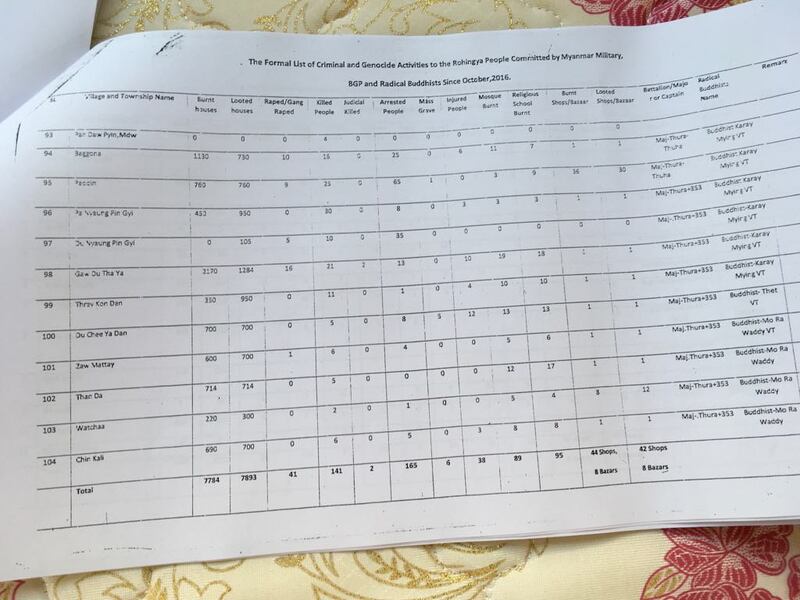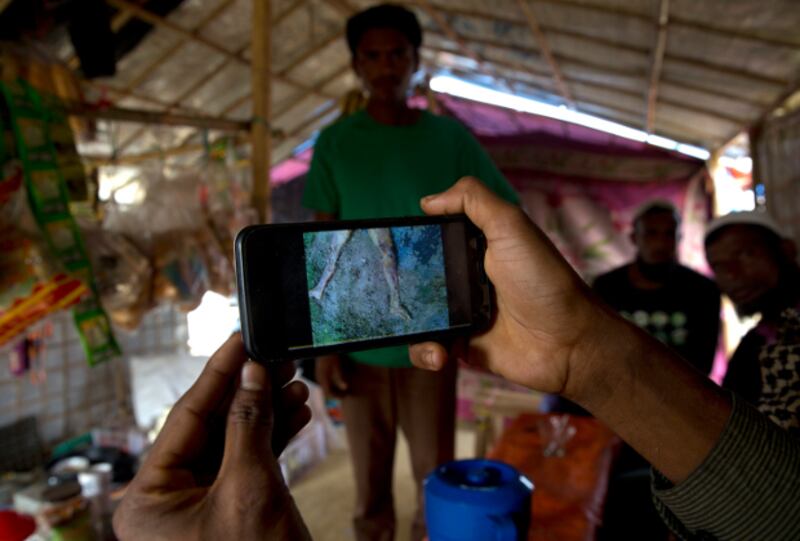Rohingya refugees in Bangladesh turned over a list of almost 4,400 Rohingya killed in Myanmar's Rakhine state since October 2016 to a U.N. envoy, who told reporters Thursday that violence against the Muslim minority bore "the hallmarks of a genocide."
The data was collected by Rohingya leaders going door to door in refugee camps in southeastern Bangladesh, according to people who took part in the effort and who shared the list with BenarNews.
Some 775,000 fled into Bangladesh as a result of disproportionate military crackdowns carried out after Rohingya insurgent attacks in October 2016 and August 2017.
"Our team visited door-to-door, talked to the refugees, and listed the level of atrocities committed by the Myanmar military, the Border Guard Police and the radical Buddhists after October 2016 and August 2017," refugee Jafar Alam, who led the effort, told BenarNews.
"According to our list, 3,942 people were immediately killed following the operations of the security forces and the Buddhists after Oct. 9, 2016, and Aug. 25, 2017, attacks in Maungdaw, Buthidaung and Rathidaung townships," he said.
At least 406 other Rohingya snatched from their homes were later found dead by their relatives, bringing the total number of people killed in the three townships to 4,348, he said.
"We have handed over the detailed list to the U.N. rapporteur on human rights in Myanmar, Yangee Lee, who visited us on January 20," said Alam, 23, a resident of Kutupalong camp.
A spokesman at the U.N. office in Dhaka confirmed to BenarNews that a group of Rohingya refugees had given the list to Lee.

430-plus bodies
The U.N. envoy, who visited Bangladesh between Jan. 18 and 24, told a news conference in Seoul on Thursday that she had "received scrolls of names of people who were allegedly killed or missing."
In December, the medical charity Doctors Without Borders (MSF) said that based on its own surveys, at least 6,700 Rohingya Muslims were killed during the first month of the August 2017 crackdown.
In September, Myanmar officials put the death toll from violence in Rakhine state in the early hundreds. They have not updated the figure since.
Myanmar government officials have strongly denied allegations of atrocities, and blame rebels from the Arakan Rohingya Salvation Army (ARSA) for much of the violence.
Lee, who like other independent investigators is barred from entering Myanmar, said that violent actions committed by the Myanmar military against the Rohingya amounted to "crimes against humanity."
In response to a question about an Associated Press report that detailed a massacre and at least five mass graves in the Myanmar village of Gu Dar Pyin, the envoy said, "These are part of the hallmarks of a genocide."
But she explained that she couldn't make a definitive declaration about genocide until a credible international tribunal had weighed the evidence.
"When I was talking to some of the refugees, a man said to me that he had buried 430-plus bodies before he escaped his town," Lee said.
In her statement simultaneously issued in Seoul and Geneva on Thursday, Lee said she interviewed more than 100 Rohingya when she visited refugee camps in Bangladesh.
"No amount of videos, photographs or news footage can prepare you for witnessing in-person the immensity of the camps and gravity of the loss and suffering experienced by the Rohingya population," she said.
"I listened as Imams stoically struggled through accounts of their villages being attacked until they broke down when revealing that their children were killed – either burned alive or shot by Myanmar security forces," she said.

Mass graves
In its report published on Thursday, the Associated Press said it had confirmed the existence of more than five previously unreported mass graves through interviews of survivors in refugee camps in and time-stamped cellphone videos.
"AP's reporting shows a systematic slaughter of Rohingya Muslim civilians by the military, with help from Buddhist neighbors – and suggests many more graves hold many more people," it said.
In Washington, a U.S. State Department spokeswoman said the department was "deeply, deeply troubled" by the report.
"We are watching this very carefully. We remain focused on helping to ensure the accountability for those responsible for human rights abuses and violations," Heather Nauert told a press briefing.
The list obtained by BenarNews is organized by village and has numbers in columns with headings such as "mass graves," "houses burnt," "raped" and "killed."
It states that in Maungdaw alone, the worst hit of three townships, 2,354 people were killed, and there could be 106 mass graves.
Alam told BenarNews that the data-gathering team could not visit five camps – Unchiprang, Leda, Saplapur, Ghundum-1 and Ghundum-2 – which house at least 100,000 more refugees.
"We did not visit the five camps as these are not government-recognized. The security situation in those camps was not good.
Besides, we do not have enough resources to go to these distant camps," he said.
He said his team spent 70 days to finish the list on Jan. 15.
"Our team members volunteered for the work. Nobody, provided us funds to complete the list," he said.
